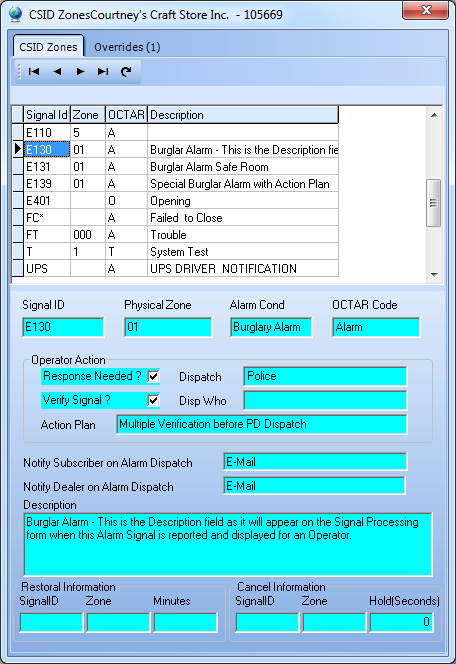 Then Click the CSID Zones on the Panel Information menu bar.
Then Click the CSID Zones on the Panel Information menu bar.
| • | The CSID Zones tab displays the following information (which may not be changed on this Form): |

CSID Zones display
| • | All of the CSID Zones for the selected CSID will be available for display. |
| • | Use the Navigator Bar to move through the records to locate the one you need to view. |

CSID Zones Navigator Bar
| • | Click on a record (in the illustration above, the record pointer4and blue highlight indicate the selected record) to see its details outlined below. |
| ▪ | Signal ID - The specific Signal Identifier for this event. |
| ▪ | Physical Zone - The Physical Zone Code, if one is transmitted with the Signal Identifier. |
| ▪ | OCTAR Code - The type of signal (Open, Close, Test, Alarm, Restore). |
| ▪ | Operator Action - The step(s) the Operator is to take when this Signal is received, if it is an Active Signal. |
| o | Response Needed? - Checked if some type of Operator Response is required. |
| o | Dispatch - If this is an Active Signal, the type of response that is needed. |
| o | Verify Signal? - Checked if this Signal is to be Verified by telephoning the premises in advance of any Dispatch, or other notification process. |
| o | Disp Who - The person that should be specifically notified for this Event when Response Needed? is Checked and Other has been selected as the Dispatch option.. |
| o | Action Plan - If an Action Plan has been assigned to this Alarm Signal, that plan's name will be shown here. |
| ▪ | Description - Provides a clear, concise description of this Signal and/or Physical Zone. |
| ▪ | Restoral Information - If the Signal has a corresponding Restoral Code, that information will appear here (also see the separate Restoral Information chapter for more detailed information): |
| o | Signal ID - The specific Signal Identifier which would indicate that the previously reported emergency condition, defined above, has been restored to its normal state. |
| o | Zone - The Zone Code, if one is transmitted with the Signal Identifier, which would indicate that the previously reported Physical Zone Code, defined above, has been restored to its normal state. |
| o | Minutes - The number of minutes the Alarm Signal, defined above, will be held by the software (this is done automatically) while awaiting this Restoral Signal. |
| ▪ | Cancel Information - If the Signal has a corresponding Cancel Code, that information will appear here. |
| o | Signal ID - The specific Signal Identifier which would indicate that the previously reported emergency condition, defined above, has been canceled. |
| o | Zone - The Zone Code, if one is transmitted with the Signal Identifier, that would indicate that the previously reported Physical Zone Code, defined above, has been canceled |
| o | Hold (Seconds) - The number of seconds the CSID Zone is placed on Hold while awaiting the Cancel Signal. |
| • | The Overrides tab displays any exception for the currently selected CSID Zone - based on the Day of the week and/or the Time - to the general processing information in the CSID Zones tab. |
| • | See Signal Processing Order to better understand how SPA and MKMSCS attempt to validate an Alarm ( Event, Test, Restoral) Signal before declaring it an Invalid Alarm. |








 Then Click the CSID Zones Icon on the Panel Information menu bar.
Then Click the CSID Zones Icon on the Panel Information menu bar.
![]()